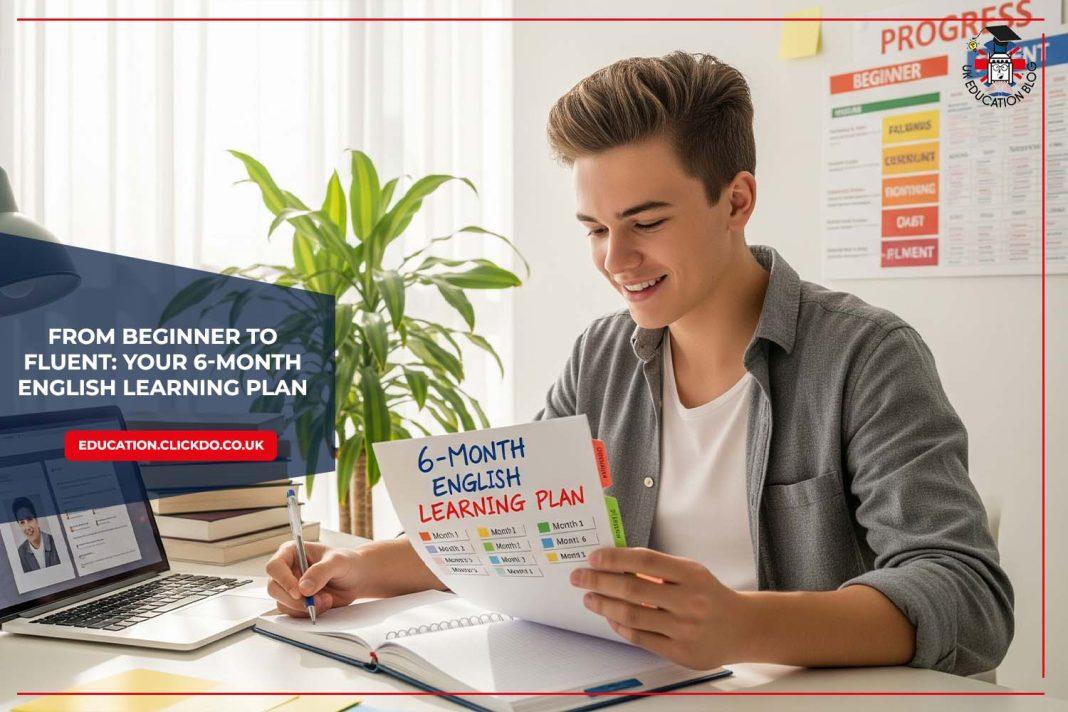Many adults decide to learn English for travel, career growth, or pure curiosity, yet excitement often turns into frustration when progress stalls. The difference between giving up and pushing forward is usually a clear, time-bound plan.
 Six months may sound ambitious, but when broken into logical phases, it becomes surprisingly realistic. Each month focuses on a narrow set of skills, ensuring effort stays concentrated.
Six months may sound ambitious, but when broken into logical phases, it becomes surprisingly realistic. Each month focuses on a narrow set of skills, ensuring effort stays concentrated.
Consistent study hours, steady exposure to authentic content, and brief self-tests at the end of every week show exactly where gains appear and where gaps remain. Instead of chasing random tips, you will follow a schedule that blends grammar drills, immersive listening, targeted speaking practice, and reflective writing.
The result is a routine that feels purposeful rather than overwhelming and a sense of daily momentum that keeps motivation high — exactly what most learners need when they decide it’s finally time to learn English effectively.
How to Learn English Effectively in Just 6 Months
Articles that promise overnight results skip the real question: how to learn English at a pace that matches adult responsibilities. The answer lies in setting monthly milestones that build on one another like ascending steps rather than disconnected leaps.
Here’s how to structure the six-month plan with clear monthly targets:
|
Month |
Main Target |
Typical Tasks (examples) |
|
1 |
Core grammar, 800 high-frequency words |
30-min grammar drills daily, 40 new words a day |
|
2 |
Everyday listening |
Watch news clips with subtitles, shadow and mimic phrases |
|
3 |
Controlled conversation |
15-min voice chats, basic role-plays and scenario practice |
|
4 |
Practical writing |
Daily 150-word journal, comment in English forums |
|
5 |
Complex listening & reading |
Podcasts, short articles related to learner’s interests |
|
6 |
Free speaking & exam practice |
Debates, mock IELTS or TOEFL speaking tasks |
Start with high-frequency vocabulary and grammar rules to build a foundation. Move into listening exercises with real speech examples to strengthen comprehension. After that, practise structured speaking, then writing, and expand into more complex input. Finish the final month with spontaneous conversation and timed assessments.
Each stage is built logically. Weekly review helps adjust goals and identify what’s improving or still lacking. Motivation stays high when learners notice actual improvement in their responses, pronunciation, and comfort level. A steady habit with realistic goals is more effective than bursts of unfocused energy.
Learning English Through Real-Life Practice and Immersion

Grammar rules are essential, but fluency only comes when learning English becomes part of daily life. Immersion builds habits and natural recall without the slow filter of translation.
Start by changing your device settings and social media language to English. This creates instant exposure in small, repetitive doses that compound over time. Choose entertainment formats you already enjoy — shows, movies, or YouTube creators — and watch them first with subtitles in your language, then with English ones. On the second viewing, repeat key phrases out loud, mimicking tone and stress.
Listening to podcasts while walking, commuting, or cooking helps your brain link new vocabulary to daily routines. Instead of pausing to translate, jot down unfamiliar words and review them later.
Reading short-form content like news headlines or product reviews offers manageable vocabulary bursts. Combine this with weekly reading of a blog or a graded article to increase stamina. Focus on understanding the meaning from context instead of translating every word.
Language exchange platforms are another essential tool. By scheduling regular fifteen-minute calls with native speakers, you practise real dialogue and quickly become more comfortable with natural speech patterns. Apps like Tandem or HelloTalk make this easy to manage on a weekly basis.
Fluency doesn’t grow in silence. Surrounding yourself with English daily, even passively, keeps it active in your mind and improves your recall and responsiveness naturally.
Study English Daily with Purposeful Tools and Routines
To study English efficiently, you need structure, not just motivation. A focused schedule paired with trusted tools makes learning faster and more sustainable. The goal is to build a rhythm that balances all key skills: speaking, listening, reading, and writing.
Use apps like Duolingo for quick grammar practice and Anki for spaced-repetition flashcards. Grammarly catches writing mistakes while helping you internalise sentence patterns. YouTube channels such as BBC Learning English offer focused lessons on pronunciation, grammar, and usage. A voice recording app lets you capture weekly speaking samples and compare your improvement over time.
The sample week below shows how to structure learning with balance and flexibility:
|
Day |
Morning (30–45 min) |
Evening (45–60 min) |
|
Mon |
Flashcards + quick grammar quiz |
Podcast + shadow key sentences |
|
Tue |
Read short article; note 10 phrases |
Language exchange call (15 min English only) |
|
Wed |
Write 150-word diary entry |
Review diary with Grammarly; correct mistakes |
|
Thu |
Flashcards + dictation exercise |
Watch sitcom clip twice; repeat dialogues aloud |
|
Fri |
Grammar mini-test |
Record 2-min talk on weekly theme; save file |
|
Sat |
Longer listening (movie segment) |
Rest or light reading (comic, blog) |
|
Sun |
Weekly review & goal setting |
Vocabulary consolidation session |
Consistency is more important than length. If you’re busy, split tasks into shorter slots spread across the day. Combine passive listening with short writing or reading tasks to stay flexible without losing progress. And always protect one rest day to avoid burnout.
Build your plan around your life, not the other way around — but once the schedule is in place, stick to it. Fluency doesn’t need magic, only structure and repetition.
Closing Reflection
Fluent speech within six months isn’t luck — it’s the result of regular habits, goal-driven practice, and smart use of tools. The hardest part of any learning plan is often the first few weeks. Progress may feel slow, but if you follow a structured approach and measure your achievements, success builds steadily. Expect temporary setbacks. These are part of the process, not a sign of failure.
Instead of waiting for the perfect moment to start, begin now. Use this plan to focus your time, simplify your study choices, and see real results each month. Every word learned and every minute spent speaking brings you one step closer to full fluency.
Author Profile

- Shirley Owen is a blogger and writer who enjoys writing blogs on education, technology and general news. An avid reader, she follows all the latest news & developments to report on them through her articles.
Latest entries
 educationDecember 11, 2025Making Education Accessible for Mobile Families that Travel
educationDecember 11, 2025Making Education Accessible for Mobile Families that Travel learningOctober 28, 20257 Daily Classroom Strategies Helping Children With Learning Differences Thrive
learningOctober 28, 20257 Daily Classroom Strategies Helping Children With Learning Differences Thrive  ed techSeptember 29, 2025How to use VR to Ace your next Exams
ed techSeptember 29, 2025How to use VR to Ace your next Exams educationSeptember 18, 2025A Guide to the European Accessibility Act for Schools and Universities
educationSeptember 18, 2025A Guide to the European Accessibility Act for Schools and Universities







